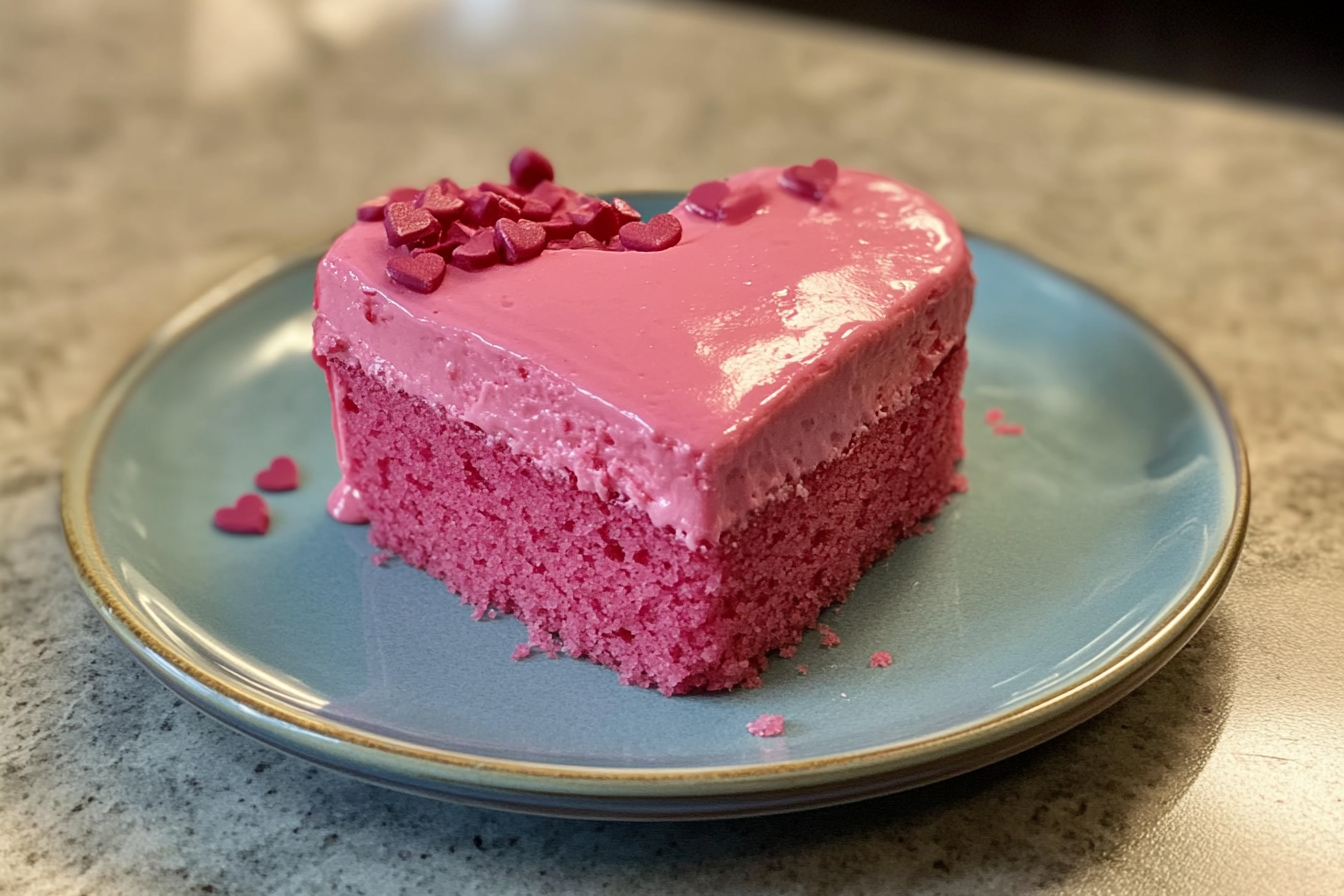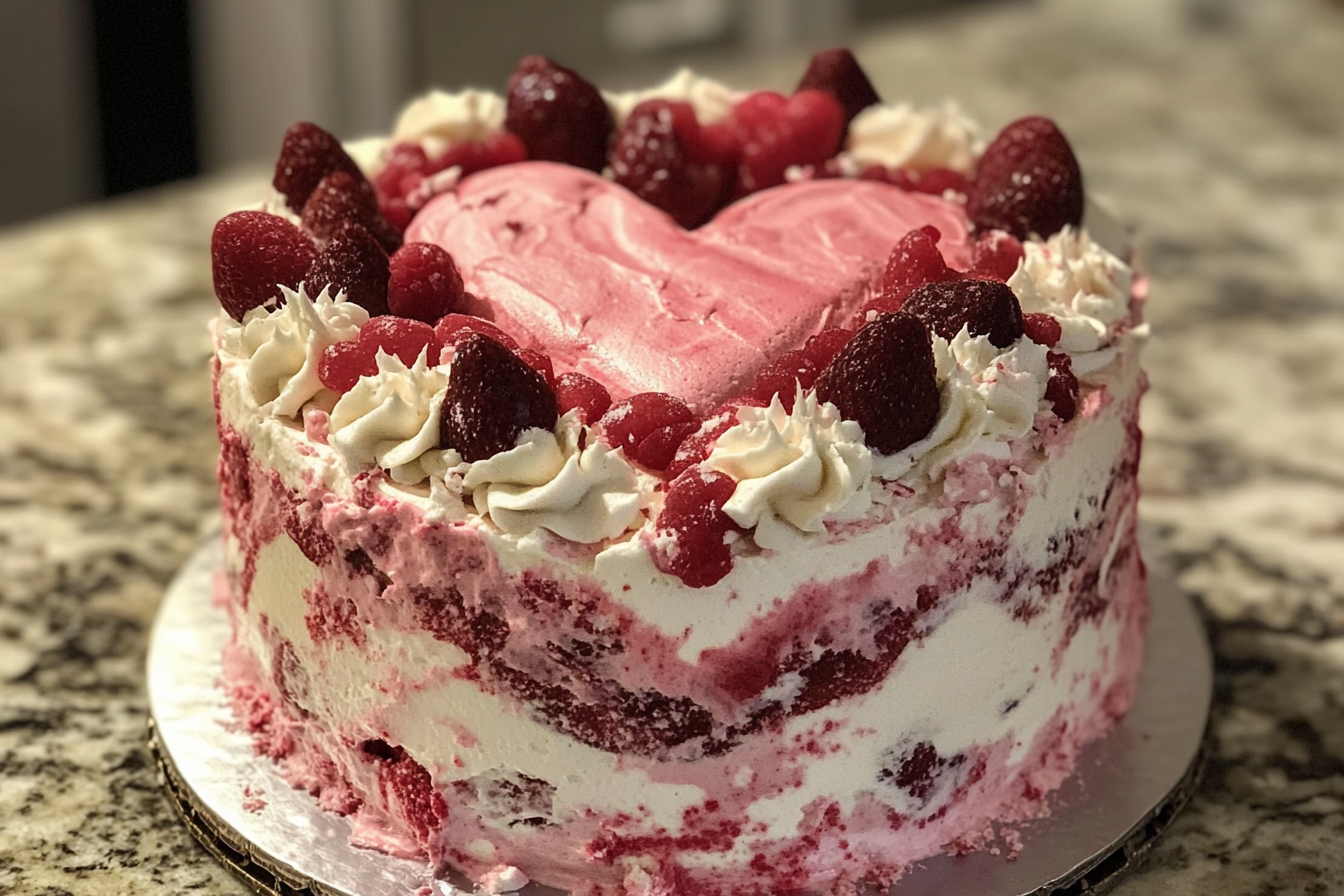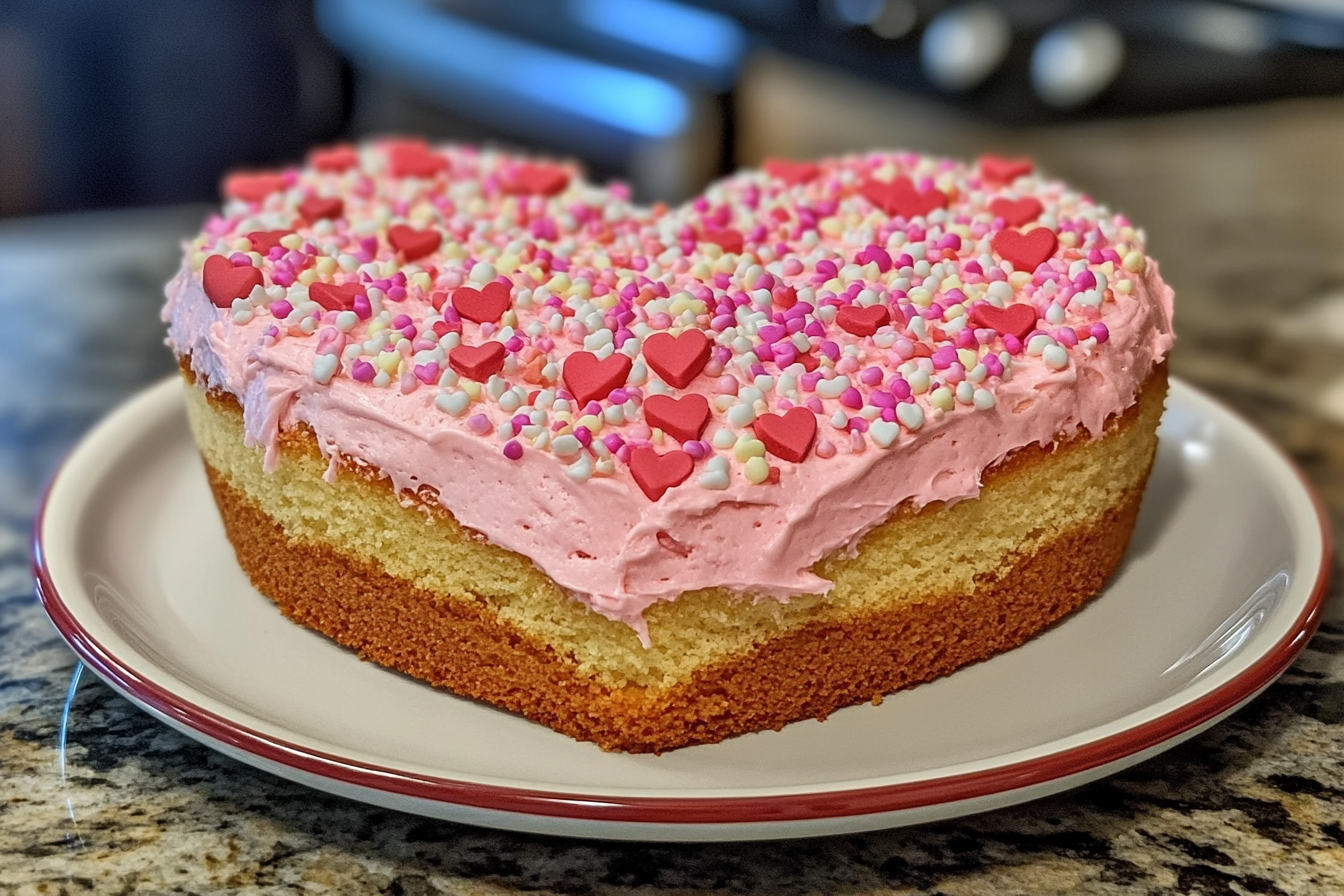Heart cakes are more than just delectable desserts. These cakes, often baked in the shape of a heart, symbolize love, affection, and appreciation. Whether served at weddings, anniversaries, or Valentine’s Day celebrations, heart cakes offer a universal way to express emotions that may be hard to articulate. The heart-shaped cake’s design, color, and presentation all contribute to its ability to convey a wide range of feelings. But what exactly is the meaning of heart cake?
The meaning of heart cake has grown stronger over time, symbolizing love and connection in various ways. Whether used to celebrate romantic love, friendships, or family bonds, heart cakes hold deep significance. In this comprehensive guide, we will explore the meaning of heart cake, its origins, cultural impact, and modern-day interpretations. We’ll also explore how bakers make heart cakes, which flavors are popular, and how people use them in different celebrations.
The Symbolism of the Heart Shape
The heart shape is one of the most universally recognized symbols of love and affection. While it doesn’t look like the anatomical heart, this symbol has come to represent the emotional core of human connection. The heart shape is often used in art, design, and even food most notably in heart cakes.
The heart shape’s association with love and emotions has roots in ancient times. Philosophers and poets often described the heart as the seat of emotions, and this connection has only strengthened over time. Today, the heart shape has transcended its original meanings, representing romantic love, familial affection, and even appreciation between friends. When incorporated into cakes, this symbol allows individuals to express these feelings in a sweet, tangible form.
Historical Significance of Heart Cakes
Origin of Heart Cakes in the 18th Century
Heart cakes have a rich history that stretches back to the 18th century. During this time, a type of cake known as Queen cakes became popular in England. Bakers often used heart-shaped tins to bake these small, individual cakes, especially for significant events. They made Queen cakes from basic ingredients like flour, sugar, eggs, and sometimes dried fruit. People typically served these cakes at tea parties, weddings, and other social gatherings, making them a staple of 18th-century British baking.
The tradition of using heart-shaped tins began with these Queen cakes. As they gained popularity, bakers began to experiment with other cake shapes, but the heart shape stood out due to its symbolic connection to love and affection. Heart cakes quickly became a symbol of celebration and emotion, often used for occasions where love was at the forefront, such as weddings and anniversaries.
History in the Making notes that heart cakes became deeply associated with romantic love, especially in the Victorian era. Their popularity grew as couples and families used them to mark special milestones. The heart shape itself became a widely recognized emblem of love, cementing heart cakes’ role as a powerful symbol of affection.
Connection to Queen Cakes
Heart cakes closely link to the historical tradition of Queen cakes. Bakers originated these small, elegant cakes during the reign of Queen Victoria and often baked them in various shapes, including hearts. They typically flavored Queen cakes with vanilla, citrus, or spices, and people enjoyed them at royal celebrations and gatherings.
As the tradition of Queen cakes spread, the heart-shaped mold became a favorite for romantic and celebratory occasions. The use of heart-shaped molds allowed bakers to create visually stunning cakes that symbolized love and connection. This practice spread beyond England and eventually became popular in other parts of Europe and the United States.
By the 19th century, heart cakes had evolved from simple Queen cakes into elaborate creations used to express deep emotions. The connection between the heart shape and romantic love became even more pronounced, and heart cakes began to appear at weddings, anniversaries, and Valentine’s Day celebrations.
Heart Cakes as Symbols of Love in Celebrations
Throughout history, heart cakes have played an essential role in celebrations of love and affection. During the Victorian era, heart cakes allowed individuals to express their feelings without the need for elaborate gestures. At a time when public displays of affection were often discouraged, heart cakes provided a subtle yet powerful way to convey deep emotions.
By presenting a heart-shaped cake, individuals could communicate sentiments of love, gratitude, or admiration without saying a word. This made heart cakes an ideal gift for romantic partners, close friends, and family members.
In modern times, the tradition of using heart cakes to express affection has continued. People present heart cakes at weddings to symbolize the love and unity between the couple, or at anniversaries to celebrate years of shared memories. The heart-shaped cake remains a beloved part of many celebrations, cherished for its ability to convey deep emotions in a simple yet meaningful way.
Cultural Impact of Heart Cakes
Heart Cakes in Western Culture
In Western culture, heart cakes are most often associated with romantic love. They have become an iconic treat for Valentine’s Day, where couples exchange heart-shaped cakes as symbols of their affection. The heart shape’s connection to the human heart, believed to be the center of emotions, makes it a perfect symbol for expressing love.
However, heart cakes are not limited to romantic occasions. They are also used to celebrate weddings, anniversaries, birthdays, and other important milestones. For example, birthday cake designs often incorporate heart shapes to express the love and care between family members or friends. Heart cakes are versatile, making them suitable for a wide range of celebrations where affection is at the center.
In Western culture, heart cakes are also used as tokens of appreciation. In recent years, more people have started giving heart cakes to friends, family, and coworkers as a way to express gratitude and admiration. The act of giving a heart cake has expanded beyond romantic contexts, making it a universal symbol of love and appreciation.
Heart Cakes in Non-Western Cultures
While heart cakes are most commonly associated with Western traditions, they have gained popularity in other cultures as well. In many Asian countries, heart cakes are becoming a popular choice for festivals, family gatherings, and weddings. Although the heart shape may not have the same cultural significance as it does in the West, it is still used to represent love, unity, and harmony.
For example, in South Asian countries, people often use heart cakes during wedding celebrations to symbolize the love and commitment between the bride and groom. Bakers decorate these cakes with intricate patterns and vibrant colors that reflect the couple’s cultural heritage. People may also give heart cakes as gifts during festivals like Diwali or Eid, where they symbolize the bonds of family and friendship.
In East Asia, heart cakes are becoming increasingly popular for birthdays and Valentine’s Day. Many bakeries offer heart-shaped cakes with flavors like matcha, red bean, and mango, which cater to local tastes. Heart cakes in these cultures are often viewed as a way to express affection and appreciation, whether for a romantic partner or a close friend.
The global popularity of heart cakes demonstrates their versatility as symbols of love and affection. While their cultural meanings may vary, the heart cake remains a universal way to express deep emotions in a tangible, edible form.
Modern Interpretations of Heart Cakes
Contemporary Designs and Flavors
In modern times, heart cakes have become more than just symbols of love they are considered works of art. Bakers now use a variety of techniques to create stunning designs that go beyond the traditional red velvet and vanilla heart cakes. From minimalist cakes with clean lines to elaborate creations adorned with buttercream flowers and fondant decorations, heart cakes have evolved to reflect modern tastes and aesthetics.
The flavors of heart cakes have also expanded in recent years. While heart cake recipes once focused on traditional options like vanilla, chocolate, and red velvet, modern bakers now offer unique flavors like salted caramel, matcha, lemon, and coffee. These new flavors appeal to a wider range of tastes, making heart cakes suitable for any occasion.
Bakers often customize modern heart cakes to reflect the preferences and personalities of the individuals celebrating. Whether it’s a simple cake for a quiet anniversary dinner or an elaborate multi-tiered cake for a wedding, heart cakes continue to be a popular way to express love and appreciation.
Heart Cakes in Social Media Culture
Social media platforms like Instagram and Pinterest have played a significant role in the modern-day popularity of heart cakes. Every year, thousands of photos of beautifully decorated heart cakes are posted online, inspiring bakers and cake enthusiasts alike. These platforms have turned heart cakes into a trend, with bakers sharing their creations and tutorials with a global audience.
Heart cakes are now a popular feature in posts about weddings, engagements, and anniversaries. Hashtags like #HeartCake, #ValentinesCake, and #WeddingCake have helped to spread the trend, as users share their favorite designs and recipes. The visual appeal of heart cakes has made them a favorite for influencers and food bloggers, who often showcase them in their posts.
Tutorials on YouTube and Instagram have also made it easier for home bakers to create their own heart cakes. Step-by-step guides from websites like Eira Recipes have empowered novice bakers to try their hand at making these beautiful cakes. As a result, heart cakes are no longer exclusive to professional bakers they have become a fun and accessible project for anyone who wants to express their creativity.
How to Make a Heart Cake at Home
Ingredients and Tools Needed
Making a heart cake at home is easier than you might think. With the right ingredients and tools, you can create a beautiful and delicious heart cake for any occasion. The meaning of heart cake shines through in homemade creations, allowing you to express love, affection, or appreciation in a personal way. Whether it’s for a birthday, anniversary, or special event, the meaning of heart cake becomes even more special when made by hand.
Ingredients:
- Cake mix or homemade batter (your choice of flavor)
- Buttercream or fondant for decorating
- Heart-shaped cake mold or pan
- Food coloring (optional)
- Edible decorations like sprinkles or flowers (optional)
Tools:
- Mixing bowls
- Electric mixer or whisk
- Spatula
- Cake turntable (optional, but helpful for decorating)
- Piping bags and tips (for detailed decoration)
Step-by-Step Guide
Step 1: Prepare the Cake Batter
Start by preparing the cake batter. You can either use a store-bought cake mix or make the batter from scratch. Popular flavors for heart cakes include vanilla, chocolate, and red velvet, but feel free to experiment with other flavors like lemon or matcha.
Step 2: Preheat the Oven and Grease the Mold
Preheat your oven to the temperature specified by the recipe. Grease the heart-shaped mold with butter or oil to prevent the cake from sticking.
Step 3: Bake the Cake
Pour the batter into the heart-shaped mold and bake for 25-35 minutes or until a toothpick inserted into the center comes out clean. Allow the cake to cool for 10 minutes before transferring it to a cooling rack.
Step 4: Decorate the Cake
Once the cake has cooled completely, it’s time to decorate. Use buttercream or fondant to cover the cake. For a smooth finish, spread the buttercream with a spatula or roll out the fondant and drape it over the cake.
You can add detailed decorations like piped flowers or personalized messages using a piping bag with a small tip. Edible decorations such as sprinkles, glitter, or fondant flowers can also enhance the appearance of your cake. If you need more decorating ideas, check out this guide on how to make a heart on a cake.
Popular Flavors and Designs of Heart Cakes
Flavor Varieties
Heart cakes are available in a wide range of flavors, offering something for everyone’s taste. Here are some of the most popular options:
- Red Velvet: A classic choice for romantic occasions, red velvet heart cakes feature a vibrant color and a soft, velvety texture. They are often paired with cream cheese frosting, which adds a tangy contrast to the sweetness of the cake.
- Vanilla: Simple yet elegant, vanilla heart cakes offer versatility, and bakers can pair them with buttercream, fondant, or other decorations. Vanilla’s neutral flavor makes it a crowd-pleasing option for any celebration.
- Chocolate: Rich and indulgent, chocolate heart cakes are perfect for those who love deep, intense flavors. They can be filled with ganache, chocolate mousse, or even a layer of fruit compote for added complexity.
- Lemon: Light and refreshing, lemon heart cakes offer a bright, tangy taste that pairs well with buttercream or cream cheese frosting. They are a great option for spring or summer celebrations.
- Matcha: A popular choice in Asian-inspired desserts, matcha heart cakes have a distinct, earthy flavor that pairs well with sweet toppings like white chocolate or strawberries.
Decorative Styles
When it comes to design, heart cakes have become incredibly creative and personalized. Here are some popular decorative styles:
- Minimalist Heart Cakes: These cakes feature clean lines and simple designs. They often have a single color or a few subtle accents, such as fondant bows or edible pearls, making them perfect for elegant events.
- Buttercream Flower Heart Cakes: Bakers adorn these cakes with intricately piped buttercream flowers, creating a romantic and visually stunning design. They pipe the flowers in various colors to match the theme of the event
- Black Heart Cakes: For a more edgy or modern look, black heart cakes are a trendy option. These cakes feature dark colors and bold designs, making them ideal for unconventional celebrations like gothic weddings or themed parties.
Heart Cakes in Weddings and Anniversaries
The Role of Heart Cakes in Wedding Celebrations
Heart cakes have long been a favorite choice for weddings, where they symbolize the love and unity between the couple. Many couples opt for heart-shaped wedding cakes as a way to reflect their romantic connection and commitment. These cakes are often elaborately decorated with flowers, lace patterns, and personalized toppers that reflect the couple’s unique style.
In addition to being a beautiful centerpiece at the reception, heart cakes also carry deep sentimental value. They serve as a visual representation of the couple’s love story and the start of their new life together. Whether it’s a single-tiered heart cake or a multi-tiered masterpiece, the cake is often one of the most memorable elements of the wedding.
Heart Cakes for Anniversaries
For anniversaries, heart cakes are a popular way for couples to celebrate their years of love and commitment. The meaning of heart cake in anniversary celebrations reflects the couple’s journey together, symbolizing the love they have shared over time. Whether it’s a first anniversary or a golden wedding anniversary, bakers can customize a heart cake to reflect the couple’s unique story. The meaning of heart cake can be further personalized by featuring photos of the couple or by displaying symbols that hold special significance for them.
In recent years, there has been a growing trend of recreating the couple’s original wedding cake for their anniversary. By using the same design, flavor, and decoration, the meaning of heart cake deepens, becoming a nostalgic reminder of the couple’s wedding day and the many years they have shared since.
FAQs About Heart Cakes
What does a heart-shaped cake symbolize?
A heart-shaped cake symbolizes love, affection, and appreciation. People most commonly use it to express romantic feelings, but it can also represent familial love, friendship, or gratitude.
Are heart cakes only for Valentine’s Day?
No, people use heart cakes for a wide variety of occasions, including weddings, anniversaries, birthdays, and other special celebrations. Bakers can customize these versatile desserts to suit any event.
What are the most popular flavors for heart cakes?
Popular flavors for heart cakes include red velvet, vanilla, chocolate, lemon, and matcha. These flavors can be paired with different fillings and frostings to create a unique and delicious dessert.
Can I make a heart cake at home?
Yes! Making a heart cake at home is simple with the right tools and ingredients. You can either use a store-bought cake mix or make the batter from scratch. Decorating the cake with buttercream or fondant allows you to customize the design to match your personal style.
What occasions are heart cakes suitable for?
Heart cakes are suitable for a wide range of occasions, including weddings, anniversaries, Valentine’s Day, birthdays, and even friendship celebrations. Their versatility makes them a popular choice for expressing love and appreciation in many different contexts.
Conclusion
Heart cakes have a deep and rich history, symbolizing love, affection, and appreciation for centuries. The meaning of heart cake has evolved from its origins in 18th-century England to its modern-day popularity on social media. Today, heart cakes continue to play a significant role in celebrations of love. The meaning of heart cake is not limited to romantic love; it also represents care and gratitude in various relationships.
For more inspiration and tips on how to create your own heart cake, visit Eira Recipes, where you’ll find tutorials and decorating ideas to help you create a beautiful and memorable dessert.



